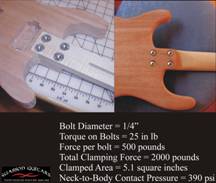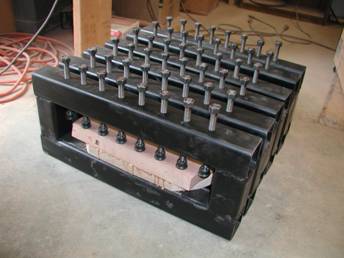
|
These are some of the unique qualities that make our guitars different. Solid quartersawn hard maple neck. Quartersawn grain structure improves strength, tone, and sustain. Our necks are solid—we do not glue up multiple pieces to try to save cost of the wood. The neck is chunked out of a solid piece of top-quality, kiln-dried hard maple, mahogany, rosewood, or other tonewood that has been selected for the best tonal qualities. Solid mahogany body. Quartersawn grain structure strengthens the neck joint, and improves tone and sustain. The mahogany body is part of what gives the guitar a deep, rich tone. The body is cut from a solid piece of top-quality, kiln-dried mahogany. There are no glue joints in our bodies except when special flame maple or quilted maple tops are applied to a one-piece mahogany backing. Special bolted neck joint. Engineering analysis was used to design a neck joint to provide the best rigid connection between the neck and body. Special steel threaded inserts are embedded into the neck. The neck is bolted to the body with 2,000 pounds (one ton) of clamping force. Special pick-up pockets. The pick-up pockets are hand-routed with uniquely designed geometry that allows the pick-ups to seat properly with minimal wood removed. The added wood stiffens the body in the area between the bridge and the neck joint. This leads to a guitar with better tone and sustain. The pockets are painted with a black conductive paint that has a nice look. Hand-carved body. The top is painstakingly hand-carved to create a uniquely sculpted body. This is not something made with a computer-controlled machine that is duplicated over and over again. Each guitar is a one-of-a-kind original that will never be duplicated. Hand-carved neck. The smoothly rounded neck is painstakingly carved by hand and countoured to the personal taste of each player. Quality finish. Our bodies are finished with 18 coats of high quality gloss nitrocellulose lacquer for a deep, rich look. A blend of stain pigments is used to arrive at a color that is one-of-a-kind. Wet sanding and hand polishing is used to produce the glass-like finish. Matching truss rod cover. The cover is hand made with inlay that is cut out by hand with a jeweler’s saw. Ebony fretboard. The one thing that is not made by hand is the fretboard. Hand work on the fret locations can compromise the quality of the instrument. A machine is well suited to perfectly cut the fret slots to exacting tolerances. The wood is high-quality African ebony. Stainless steel frets. Stainless steel means you don’t have to worry about corrosion. They also have superior wear resistance, which means they will last longer without needing rework. The frets are installed, smoothed, and polished by hand. The fretboard is leveled on a precision granite surface plate used to make high precision machine tools. Fretboard Inlays. Cut out by hand with a jeweler’s saw. Hand-routed control cavity. The cavity is painted with a black conductive paint that shields electrical noise and also has a nice look. Matching hand-made control cavity cover. The cover is made from the same mahogany and finished the same as the body. The inner side of the cover is painted with black conductive paint for shielding. Machine screws for cavity cover. The control cavity cover is held on with machine screws, not wood screws. Because the threads in the body are metal, you can take this cover off and on as many times as you want without worrying about screwing up the threads in the body. Unique jack socket. The socket is a Wasson original made from stainless steel. You can’t buy these anywhere because it was machined custom by the builder himself. The socket is hard so it won’t scratch from repeated use. Strap locks. The front button is installed with a special, curved washer that is a Wasson original part made from stainless steel. This is just another unique touch that separates Wasson guitars from the rest. Hand-signed and serialized by the builder. Will your guitar someday be a collector’s item? |

|
2,000 pounds (one ton) of clamping force. The contact between the neck and body must be high pressure in order for the two structures to work together without loss of vibration at the interface. Necks attached with wood screws or poorly glued interfaces have reduced quality of tone and sustain. |
|
Neck Joint Quality |
|
Body Fabrication |
|
54,000 pounds (27 tons) of clamping force. Specially made fixture for clamping maple tops to mahogany body backs during glue procedure. The wood pieces are clamped with 54,000 pounds (27 tons) of force. This ensures contact pressure is above the threshold pressure required for the two halves of the body to behave as one unique structural member.
Bolt diameter = 0.5 inches Torque = 15 foot-pounds Force per bolt = 1800 pounds Bending stress in steel frame = 13,900 psi 30 Bolts deliver 54,000 pounds (27 tons) Clamping pressure between wood pieces = 180 psi |
|
Quality Construction Throughout the Entire Guitar |


